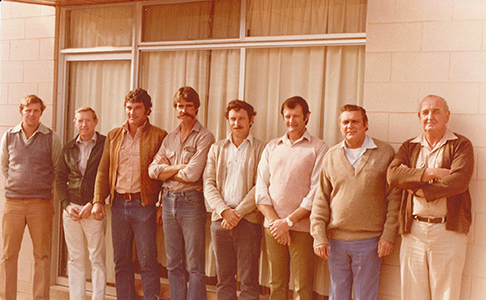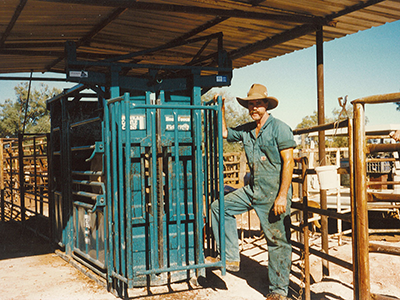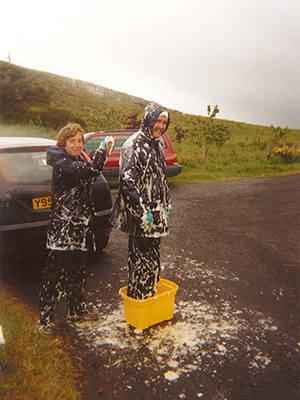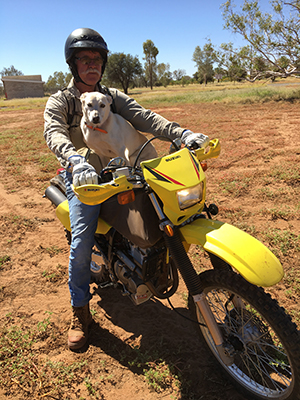Bryan Gill – retiring after 40 years working for the Central Australian pastoral industry
Bryan Gill retired at the end of October after 40 years of public service in Central Australia. Most people in the industry know him as ‘Gilly’, and he is well respected for his knowledge and dedication to pastoralism in Central Australia.
Gilly spent his school holidays in Central Australia, dreaming of riding horses and working cattle when he grew up. As a teenager, Gilly began his career in the cattle industry as a stockman on Undoolya Station where he worked for the legendary cattleman Edward (Ted) Hayes. He learnt skills and gained knowledge that he has used throughout his career.
Brucellosis and Tuberculosis Eradication Campaign
In 1982, Gilly was employed as a Stock Inspector with the Department of Primary Production to implement the National Brucellosis and Tuberculosis Eradication Campaign (BTEC). In order to maintain Australia’s international market access, BTEC was established to eradicate the diseases, which involved testing and destocking of domestic and wild herds. For many stations, it wasn’t possible to obtain a clean muster because of the type of country and minimal infrastructure and many animals had to be culled.
Gilly had a lot of sympathy for the producers but he thoroughly believed in why they were doing the job. Some producers were pretty angry about the program but mostly they earned Gilly’s respect because they still got on with the task at hand.
BTEC was a big program for a number of years with Australia declared bovine brucellosis free in 1989 and bovine tuberculosis free in 1997.

Advisory and Extension Services
As BTEC became less of a priority, Gilly continued to work with the cattle industry as an Advisory Officer; bull testing, conducting artificial insemination programs, preg testing, organising and delivering field days and industry-specific courses. As part of the Advisory Services team, Gilly was involved in the preparation and delivery of the inaugural Meat Profit Field Day in 1995.
Gilly has also made contributions to many research projects during his career with the Department offering both practical skills and expertise, and bringing a valuable perspective as someone who has worked closely with producers for many decades.
He has been a strong supporter of the Alice Springs Show and the Tennant Creek Show, particularly the cattle sections. This involved getting Arid Zone Research Institute (AZRI) cattle ready for competition (the AZRI cattle have won many trophies in Gilly’s time!) and teaching kids how to handle poddy calves.

Foot and Mouth Disease Outbreak in the United Kingdom
In 2001, Gilly, along with many other stock inspectors from Australia, travelled to the United Kingdom to assist with the Foot and Mouth Disease eradication program. Much like BTEC, one of the hardest parts of the job was watching farmers struggle with the loss of their stock. Aside from the obvious loss of their livelihood, the scale of farming meant that many farmers knew their animals as individuals, in many instances having given them names.
There were some funny moments amongst the hard work. Veterinary assistance came from around the world and Gilly often found himself working as a translator. He recalls having to ‘translate’, even though everyone spoke English, for a veterinarian with a fast, strong Greek accent, who was trying to communicate with a British farmer with his own distinct regional accent and local slang!

A skilled cattleman
Gilly is a firm believer in quiet, low-stress stock handling practices. Producers, visitors and stock agents regularly praise the beautiful temperament and quality of the research station cattle and while some of that is due to selective breeding, much of it can be attributed to the handling and management they have received. For example, all the weaners receive two weeks training so that they are familiar with being moved by people, motorbikes and dogs and the sale steers undertake ‘practice runs’ through the yards and loading on to trucks so that by the time they are sent to market, they are calm and quiet. He is, quite rightly, very proud of the steers that will calmly load on to a truck, with no jiggers or yelling, one after the other and waiting their turn – almost without any influence from people.
Gilly’s observations of cattle behaviour have led to improvements in welfare and productivity for the research herds. Wherever possible, cattle are given the time and space to form and maintain social groups and this helps keeps them quiet when being handled. Observing that cattle also travel best when stress is low immediately prior to trucking, Gilly recalls the first time he allowed the premium sale steers out into a holding paddock the night before trucking. That way they could move, graze and rest without the anxiety and tension that can often build when cattle are held in a yard. Of course, this increased Gilly’s stress as he spent a sleepless night worrying the cattle would all escape by morning!

Old Man Plains Research Station Manager
In 2004, work began on the Old Man Plains Research Station (OMP). Since then, Gilly has been a key contributor in the development and management of the property and he has been the Research Station Manager since about 2015. The most significant research trial during his time as manager at OMP has been the Quality Graze project. This trial has been important in proving the value of using long-term carrying capacity recommendations to achieve and maintain both cattle production and land condition improvement in a highly variable climate. Gilly has become a strong advocate of the project and he would love to change the widely-held perception that uneaten feed is wasted, and hopes the industry can also see the many benefits of having reserved feed.
It wasn’t all hard work
Gilly has a good sense of humour and more than a little inclination towards the mischievous! He has a strong community spirit and was a long-serving committee member and president for the AZRI Social Club. There are volumes of photographs that document many cricket matches, Melbourne Cup luncheons, farewells and Christmas parties and Gilly is in many of these photos, often in fancy dress, and very often working the BBQ.
A Master
Like many people who spend a long time in the Northern Territory, Gilly has worked with many clever and experienced people, producers, technical experts and research scientists. Of course, he is a wealth of knowledge himself and he generously passes on that knowledge to anyone who is willing to learn. In particular, his expertise in managing and handling cattle is exceptional, and it is widely recognised that he is a well-respected cattleman in his own right. Thank you, Gilly, for your hard work, generosity and support over the past 40 years.

